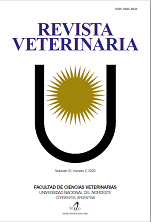Eliminación de residuos de oxitetraciclina y fosfomicina en calostro y leche de cerda: efecto sobre la camada
DOI:
https://doi.org/10.30972/vet.3124735Palabras clave:
cerda, lechones, calostro, leche, antibióticos, resistencia bacterianaResumen
El objetivo del presente trabajo fue estudiar la eliminación de oxitetraciclina (OTC) y fosfomicina (FOS) en calostro y leche de cerda, su impacto sobre algunos aspectos microbiológicos y morfo-fisiológicos intestinales, así como parámetros zootécnicos de la camada. Se analizaron muestras de calostro y leche de cerdas tratadas durante el peri-parto con OTC solución y FOS disódica vía intramuscular. Se evaluó la ingesta de calostro con concentraciones residuales de antibióticos, así como parámetros intestinales y zootécnicos de lechones lactantes. Las concentraciones medias residuales de OTC y FOS en calostro/leche fueron 0,48 y 1,55 µg/ml y la ingestión media de antibiótico/lechón fue de 0,13 y 0,50 mg/kg peso vivo, respectivamente. Si bien la ingestión de calostro con residuos de FOS mostró menor impacto que OTC sobre los aspectos microbiológicos y morfo-fisiológicos, así como sobre la bioquímica enzimática intestinal de lechones lactantes, ambos antibióticos no afectaron los resultados de los parámetros zootécnicos de las camadas. No obstante, las bajas concentraciones de antibióticos ingeridos con el calostro serían un potencial riesgo de desarrollo de resistencia bacteriana, por lo cual la aplicación profiláctica de los mismos durante el peri-parto debería ser reconsiderada.Descargas
Citas
Baxter EM et al. 2008. Investigating the behavioural and physiological indicators of neonatal survival in pigs. Theriogenology 69: 773–783.
Bradford MM. 1976. A rapid and sensitive method for the quantitation of microgram quantities of protein utilizing the principle of protein-dye binding. Anal Biochem 72: 248-254.
Caswell AH, Hutchison JD. 1971. Selectivity of cation chelation to tetracyclines: evidence for special conformation of calcium chelate. Biochem Biophys 43:625-630.
Dahlqvist A. 1964. Method for assay of intestinal disaccharidases. Anal Biochem 25: 18-25.
Dejong A et al. 2014. Antimicrobial susceptibility monitoring of respiratory tract pathogens isolated from diseased cattle and pigs across Europe, the vetpath study. Vet Microbiol doi:10.1016/j.vetmic.2014.04.008.
Delatorre E et al. 2014. Detection of integrase gene in E.coli isolated from pigs at different stages of production system. Int J Microbiol 2014: 1-7.
Delatorre E et al. 2016. Multidrug resistance in Escherichia coli carrying integrons isolated from a pig farm with moderate antibiotic use. J Gen Appl Microbiol 61: 270-273.
Devillers N, Vanmilgen J, Prunier A, Ledividich J. 2004. Estimation of colostrum intake in the neonatal pig. Anim Sci 78: 305-313.
F.Paggi MB et al. 2018. Fosfomycin residues in colostrum: Impact on morpho-physiology and microbiology of suckling piglet. J Vet Pharmacol Ther 41: 415-427.
F.Paggi MB et. al. 2012. Estudio de la distribución del antibiótico fosfomicina en calostro-leche de cerdas. Analecta
Vet 32: 5-10.
Fernández P, Herrera I, Martinez P, Gomez ML, Prieto J. 1995. Enhancement of the susceptibility of Staphylococcus aureus to phagocytosis after treatment with fosfomycin compared with other antimicrobial agents. Chemotherapy 41: 45-49.
Fritz JW, Zuo Y. 2007. Simultaneous determination of tetracycline, oxy-tetracycline, and 4-epitetracycline in milk by high-performance liquid chromato-graphy. Food Chem 105: 1297-1301.
Gyawali R, Minor RC, Donovan B, Ibrahim SA. 2015. Inclusion of oat in feeding can increase the potential probiotic bifidobacteria in sow milk. Animals 5: 610-623.
Jouany JP. 1982. Volatile fatty acid and alcohol determination in digestive contents, silage juices, bacterial cultures and anaerobic fermentor contents. Sciences des Aliments 2: 131-144.
Kisielinski K, Willis S, Prescher A, Klosterhalfen B, Schumpelick V. 2002. A simple new method to calculate small intestine absorptive surface in the rat. Clin Exp Med 2: 131-135.
Klein U et al. 2015. Antimicrobial susceptibility monitoring of respiratory and enteric tract pathogens isolated from diseased pigs across Europe between 2009 and 2012. In: 7th European Symposium of Procine Health Management - www.pig 333.com/calendar/7th-european-symposium-ofporcine-health-management-esphm.
Ledividich J. 2006. Les enjeux du colostrum. Expo-Congrès du Porc du Quebec, p. 49-72.
Ledividich J, Rokke JA, Herpin P. 2005. Nutritional and immunological importance of colostrum for the new born. J Agric Sci 143: 469-485.
Manners MJ. 1976. The development of digestive function in the pig nutrition. Proc Nutr Soc 35: 49-55.
Martineau GP. 1997. Maladies d’elevage des porcs, Manuel Pratique, Ed. Fr. Agric. 479 p.
Piel C, Montagne L, Sève B, Lallès JP. 2005. Increasing digesta viscosity using carboxymethylcellulose in weaned piglets stimulates ileal goblet cell numbers and maturation. J Nutr 135: 86-91.
Rutherford KM et al. 2013. The welfare implications of large litter size in the domestic pig. I: Biologica factors. Anim Welf 22: 199-218.
Sande MA, Mandell GL. 1991. Agentes antimicrobianos:
tetraciclinas, cloran-fenicol, eritromicina y agentes antibacterianos varios. Ed. Médica Panam., Buenos Aires, Argentina, p. 1083-1109.
Sumano LH, Ocampo CL, Gutierrez OL. 2007. Intravenous and intramuscular pharmacokinetics of a singledaily dose of disodium-fosfomycin in cattle, administered for 3 days. J Vet Pharmacol Ther 30: 49-54.
Tamai I, Tsuji A. 1996. Carrier-mediated approaches for oral drug delivery. Adv Drug Deliv Rev 20: 5-32.
Zhang H, Malo C, Buddington RK. 1997. Suckling induces rapid intestinal growth and changes in brush border digestive functions of newborn pigs. J Nutr 127: 418-426.
Descargas
Publicado
Cómo citar
Número
Sección
Licencia
Derechos de autor 2021 M. B. Fernández, J. M. Decundo, G. O. Martínez, S. N. Diéguez, A. L. Soraci

Esta obra está bajo una licencia internacional Creative Commons Atribución-NoComercial 4.0.
Política de acceso abierto
Esta revista proporciona un acceso abierto inmediato a su contenido, basado en el principio de que ofrecer al público un acceso libre a las investigaciones ayuda a un mayor intercambio global de conocimiento. La publicación por parte de terceros será autorizada por Revista Veterinaria toda vez que se la reconozca debidamente y en forma explícita como lugar de publicación del original.
Esta obra está bajo una licencia de Creative Commons Reconocimiento-NoComercial 4.0 Internacional (CC BY-NC 4.0)










.jpg)
.jpg)



